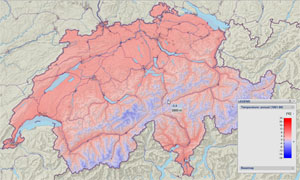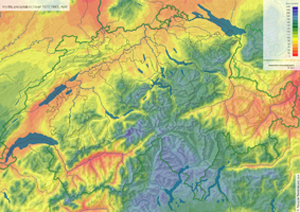|
|
Numeric data
Contrary to nominal and ordinal maps, the numeric map reveals the quantitative character of collected data. Regarding
numeric map information, we have to consider two different types of data: Interval and Ratio data.
Interval data
The interval level of collected data have three characteristics:
- The categorisation of data
- The ordering of data, but with...
- ...explicit numerical indication of the categories value
Interval example
 Interval Data Example, Atlas of Switzerland 3 (Bundesamt für Landestopografie swisstopo (eds.) 2010) Interval Data Example, Atlas of Switzerland 3 (Bundesamt für Landestopografie swisstopo (eds.) 2010) |
Example: Temperature in Switzerland (mean annual temperature 1961-1990, degree celsius). A classic example for interval data is the temperature scales of CELSIUS and FAHRENHEIT. Both scales consist of ordered values and reveal the precise difference between their temperature values. However, the problem of these interval scales is the arbitrary character of their zero points. |
Ratio data
Ratio data has the same characteristics as interval data:
- The categorisation of data
- The ordering of data, but with
- The explicit numerical indication of the value differences between the categories.
However, contrary to interval data, ratio data has no arbitrary but an absolute zero point. In many fields, it is very
common to work with ratio data.
Continuing with the example of temperatures, we state that the KELVIN scale has an absolute zero point and therefore has a
ratio scale. This absolute zero point of temperature is the lowest possible temperature of anything considered in the universe.
Thus, we are allowed to say that 30°K is twice as warm as 15°K, also in terms of kinetic energy of molecules (Slocum 1999).
Ratio example
 Ratio Example, Atlas of Switzerland 1 (Bundesamt für Landestopografie swisstopo (eds.) 2000) Ratio Example, Atlas of Switzerland 1 (Bundesamt für Landestopografie swisstopo (eds.) 2000) |
Example: Precipitation in Switzerland (average April, in mm). The registration of precipitation has an absolute zero point too. If there is no rain falling, we measure 0 mm of precipitation. So we can say that 1000 mm is twice as much as 500 mm because precipitation relies on ratio data. |
